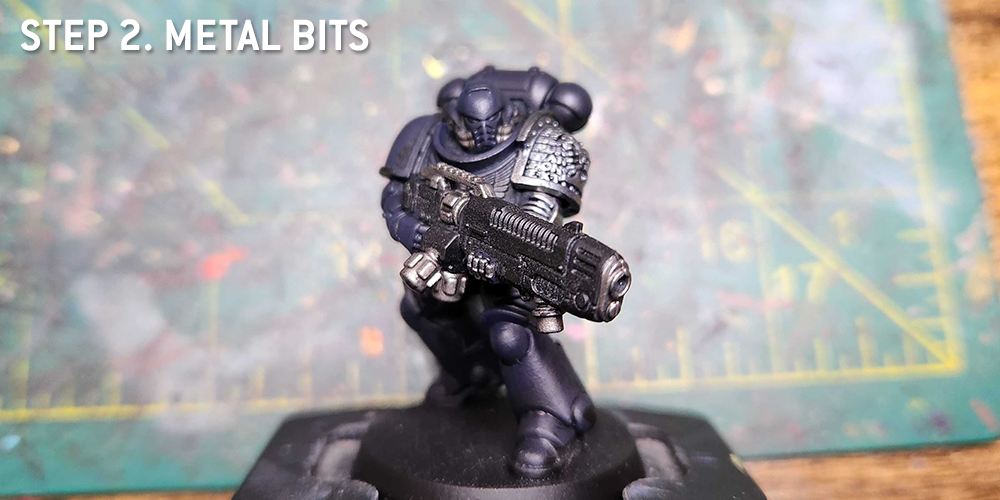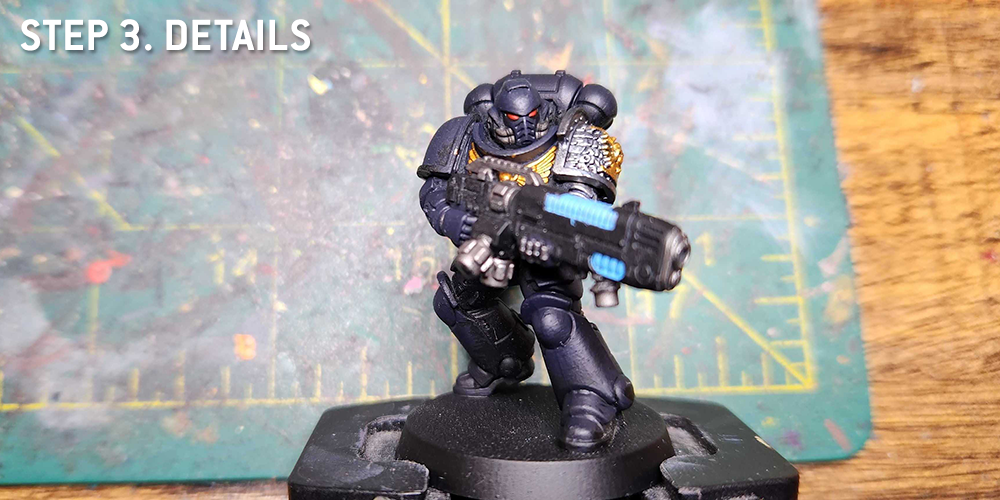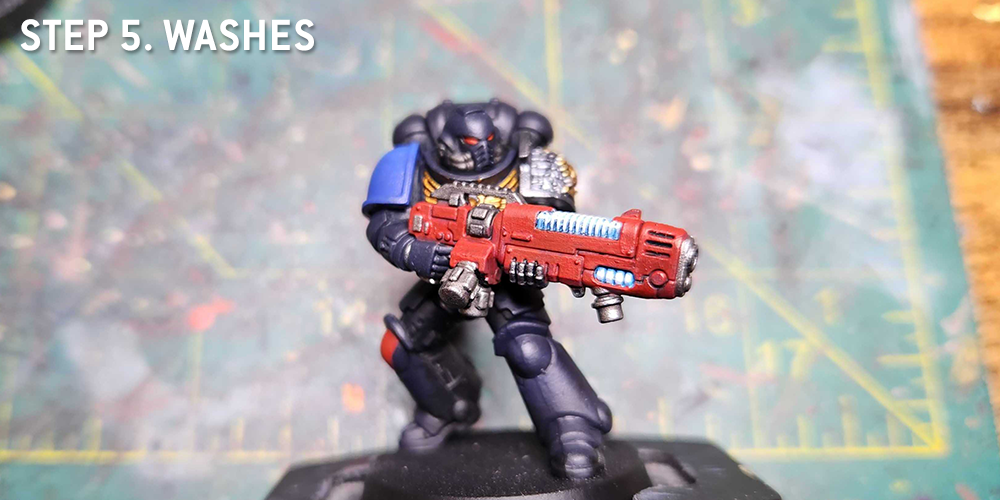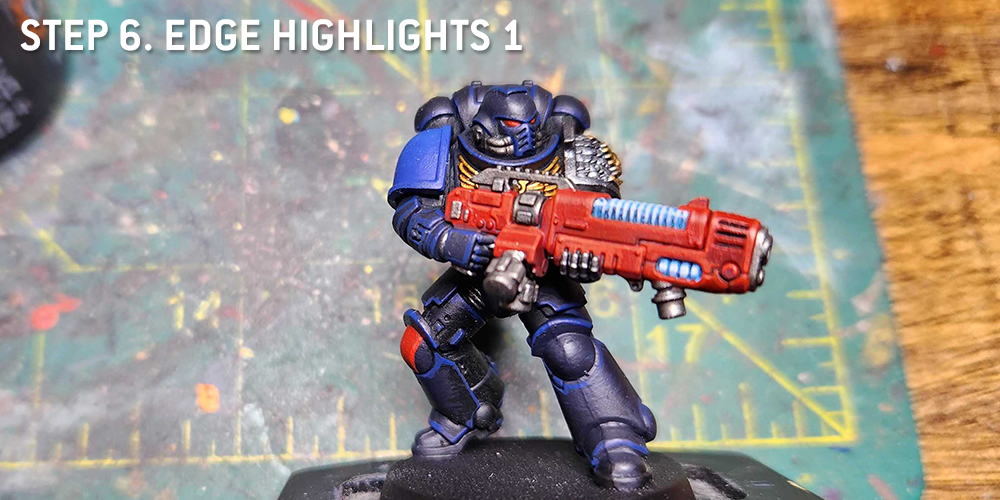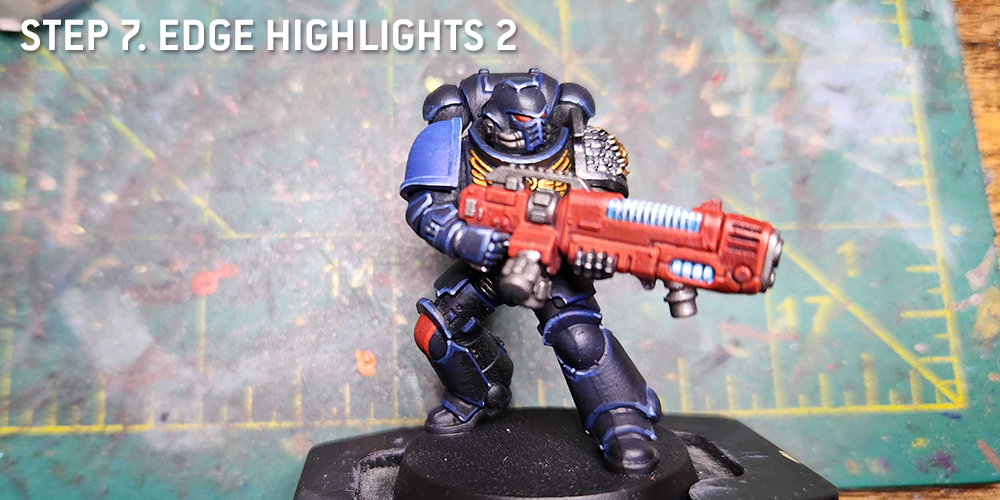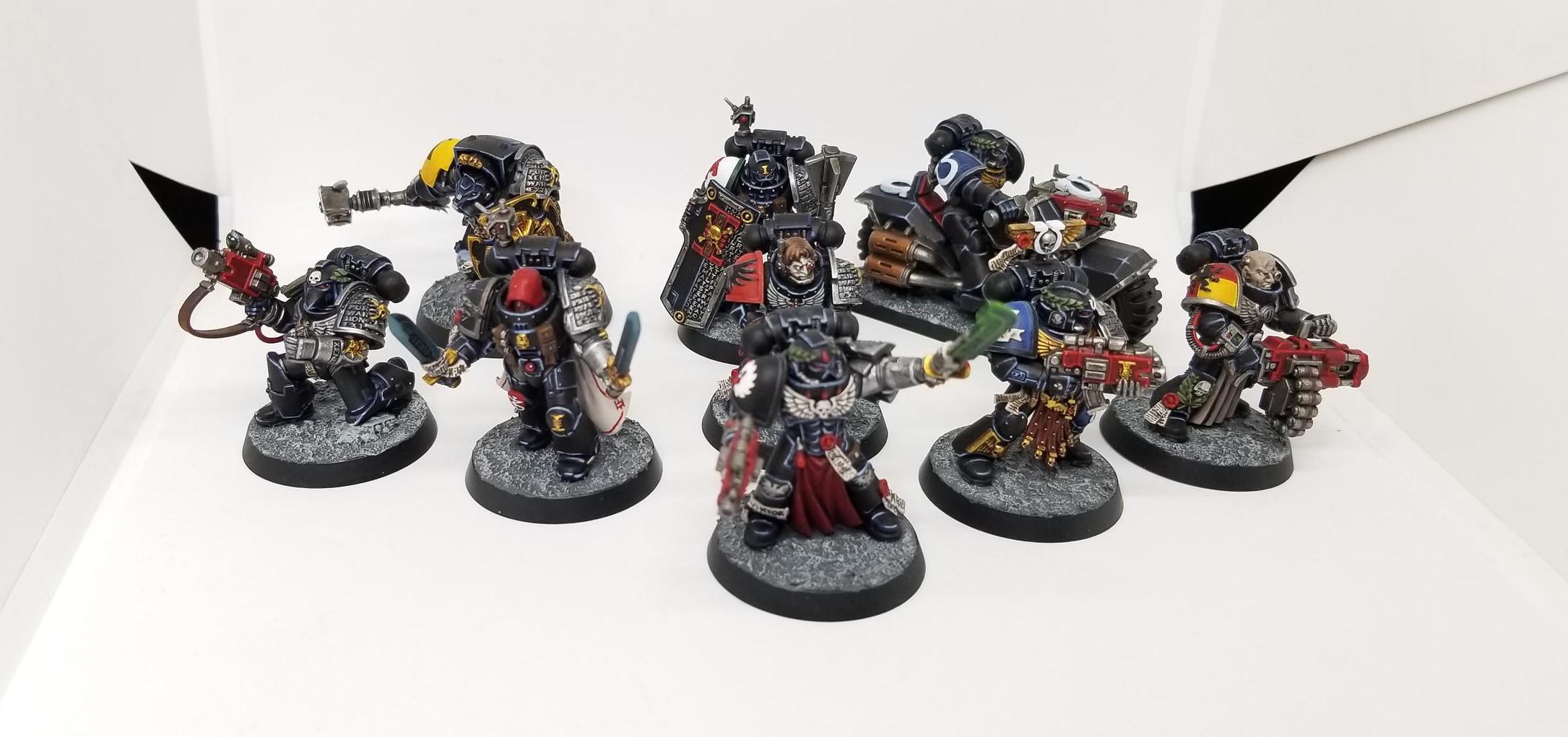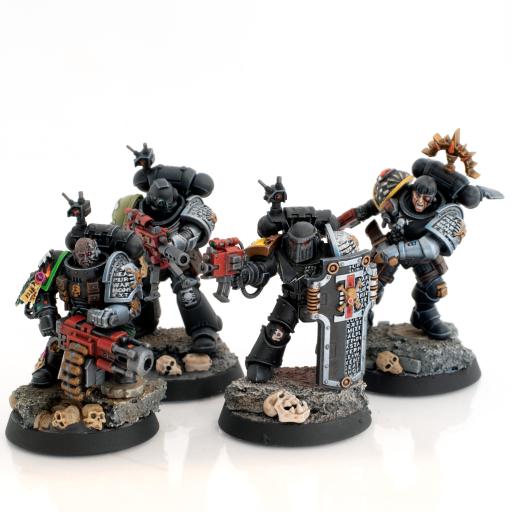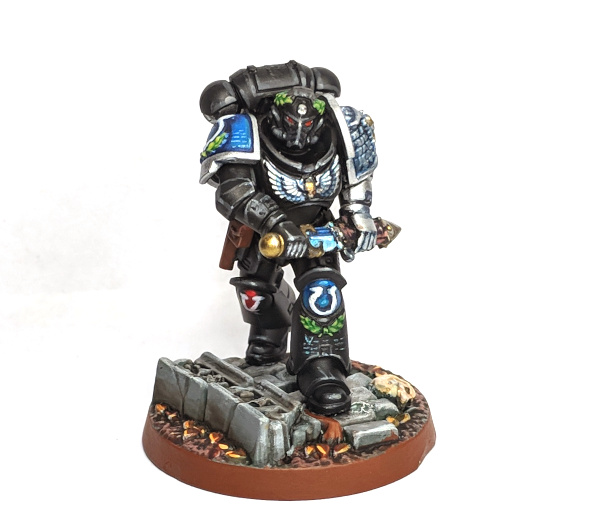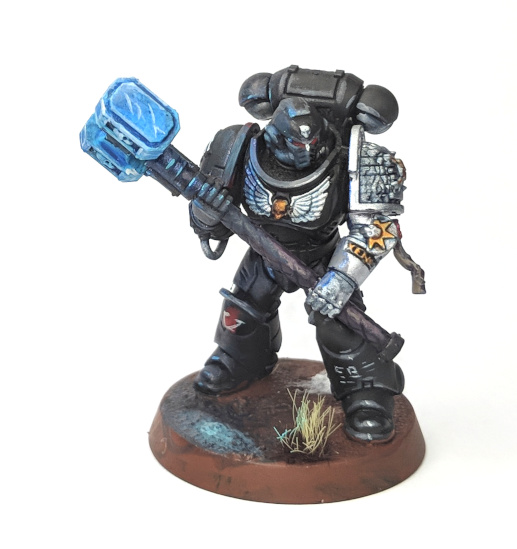This article is part of a larger series on how to paint Space Marines. To return to that series, click here.
In our How to Paint Everything series, we take a look at different armies of the Warhammer universe, examine their history and heraldry, and look at several different methods for painting them. In this week’s article, we’re looking at the Deathwatch.
Founded by decree of the High Lords of Terra in the wake of the Ork campaign led by the tyrant known as The Beast, the Deathwatch are an elite group of Space Marines trained specially to fight Xenos threats. They operate as a branch of the Ordo Xenos Inquisition in much the same way that Grey Knights operate as members of the Ordo Malleus. Unlike Grey Knights however, Deathwatch Marines are not exclusive to the Deathwatch; instead they are veterans recruited from chapters across the galaxy to serve in the Deathwatch for a limited time before returning (should they survive). To be chosen to serve in the Deathwatch is considered a great honor for a Space Marine, and the details of their missions and service are kept secret under oaths made to the Inquisition.
For the Imperium, the Deathwatch are the best of the best when it comes to hunting aliens, an elite force outfitted with custom technology, armor, and tactics designed specifically to take on Xenos threats. Unlike Space Marine chapters, the Deathwatch do not abide by the Codex Astartes, and operate not as regimented squads but instead as a series of Kill Teams, small units of special forces that combine multiple specialties and armaments to accomplish specific tasks. In larger battles a Deathwatch army may field multiple Kill Teams to accomplish a goal, though for large-scale threats the Deathwatch will usually call on the help of the Astra Militarum or a chapter of regular Space Marines. Although their squads are different, Deathwatch are still organized into companies and have multiple chapters spread across a series of fortress-monasteries.
The Deathwatch were prominently involved in the awakening of Ynnead, the Eldar god of the dead. A Deathwatch kill team led by Watch Captain Artemis was dispatched to take out Eldrad Ulthran and his Harlequin allies from awakening the sleeping god, though at the time the Deathwatch had no idea what the ritual was for. They succeeded in their task of stopping the ritual, though Eldrad was still able to cause the god to stir, ultimately awakening to a limited degree some time later. Most recently, the Deathwatch have been fighting off threats from within, rooting out and destroying Genestealer Cults on key planets throughout the Imperium.
Covered in this Article
- How to Paint the Deathwatch, with different methods for painting their black and silver armor.
- Notes on the Heraldry of the Deathwatch.
Deathwatch Heraldry - Click to Expand The Deathwatch are unique among Space Marine forces in that they recruit their members from other chapters, to serve in the Deathwatch for a limited period of time. Though considered a Chapter, the Deathwatch have no home world but instead spread across a number of isolated, independent Watch Fortresses, each of which maintains several companies. The Deathwatch do not follow the Codex Astartes, and operate very fluidly from a tactical perspective. Each Deathwatch marine dons black armor save for their left arm, which is clad in silver and protected by a silver Deathwatch shoulder pad marking them a member of the Deathwatch. Their right shoulder pad bears the heraldry of their original chapter, and may or may not include the trim color appropriate to their company, as you see fit to include. The Deathwatch mark their groups and companies, using red bands (vertical, horizontal, and diagonal) and white gothic script.
Painting Deathwatch
Deathwatch wear primarily black armor with two notable exceptions: The left arm, which is painted silver, and their right shoulder pad, which retains the heraldry of their original chapter. Because they come from all different chapters, many Deathwatch marines retain badges and markers from their original chapters, which makes modeling and painting them a real joy – if you’ve ever wanted to paint just one marine from a given chapter, the Deathwatch are a great way to compromise on this, letting you source bits for and model many different chapters without having to commit to a larger force or being left with unusable models.
While the scheme may seem simple overall, there are multiple ways to tackle painting black and silver, and as always, we’re covering several different approaches.
TheChirurgeon's Method - Click to Expand I started doing Deathwatch right before the Deathwatch: Overkill boxed set came out, which was a blessing and a curse. On the one hand, it was great to suddenly get lots of new models for the army I wanted to build. On the other hand, I had just bought a bunch of (small) metal shoulder pads that I now had no use for! Deathwatch have been a blast to work on, mostly because sourcing bits to make each model and tell its story is just a lot of fun. Normally I paint black armor using Corvus Black as the highlight color and Mechanicus Standard Grey for the edge highlights (you can find that method in my tutorial on Raven Guard, here). For my Deathwatch I use a more blue scheme, with blue highlights, and I’ve recently refined the method to this updated version. I started by priming the model black. I’m going with a blue-r look for my armor, and that means something other than Corvus Black. Following the old ‘Eavy Metal recipe, I highlighted my marine here using a mix of Kantor Blue and Black Legion Contrast paint. This happens in 2-3 steps, working up to a 50/50 mix of the two. The goal here is to add some depth and color to the black armor. Next comes the metal parts. I paint those with Leadbelcher. Nothing too fancy here. Time for the not metal bits. I paint the eyes with Mephiston Red, the skull icon and chest aquila here get a coat of Retributor Armour, and the coils on the hellblaster get painted Lothern Blue though in retrospect I’d just use Baharroth Blue next time. Note that when I paint my Deathwatch minis, I tend to paint their chest aquila matching whatever it’d look like for their chapter. Time for the red parts! I paint these with Khorne Red, then highlight that with Mephiston Red. Those parts will get washed with Carroburg Crimson and then edge highlighted later with Evil Sunz Scarlet, which also highlights the eyes. Here’s where I formally add the Carroburg to the red parts but there’s more to do. Here’s also where I hit the metal bits. Every metal part except the left arm gets a coat of Nuln Oil. Meanwhile the left arm gets a coat of Drakenhof Nightshade to give it more of a blue hue. The gold parts get a wash of Agrax Earthshade. Step 6. Edge Highlights 1 The first round of edge highlights is the most time-consuming. The red parts get edge highlights of Evil Sunz Scarlet. The gold parts get a bit of Retributor Armor and Runefang Steel. The metal left arm also gets edge highlights of Runefang Steel. Then there’s the armor. I do a pass edge highlighting the black armor with Kantor Blue. A second and third pass on edge highlights. The kantor blue liines get a second pass (toward the edges) with Reaper Snow Shadow, and then the corners and highest parts get a bit of Reaper Ghost White. At this point, we’re pretty much done, but I’ll add some OSL to the gun before I’m done with the unit. The biggest thing about doing Deathwatch is to enjoy the assembly/modeling process. Not only does the Deathwatch Veterans sprue have a ton of great bits to play with, but you’ve also got 20 to 30 years of model history to draw on when you sit down to create your models! Even if I don’t remember all their names, I try and think of each model as an individual and how I can reflect their chapter’s heritage on their model. I like to look for inspiration by going through Lexicanum or other sources and finding prominent Deathwatch members in the fluff that I can convert. I also like to look through marine chapters that have been featured for ideas on how to make one of them for my Deathwatch. That’s how I got my Deathwatch Apothecary, who is Red Scorpions Apothecary Krieger Thann. Ebay bits resellers are great for doing Deathwatch by the way – I’ve got tons of bits I’ve picked up from small purchases here and there and I’m constantly going back through my bits box for additional things I can put onto a Deathwatch mini. Stuff like Blood Angels torsos work well not just for Blood Angels but also Minotaurs and other GrecoRoman-themed chapters.Step 1. Basecoat
Step 2. Metal Bits
Step 3. Details
Step 4. Red Bits
Step 5. Washes
Step 6. Edge Highlights 2
Building Character
Alfredo's Method - Click to Expand I have quite a few Deathwatch models painted for Kill Team and what I love about them most is the fact that you can make every model a character, telling a unique story, and really take advantage of the depth of many Space Marine kits to create really unique models. I’m going to cover the main colors on all Deathwatch and then some thoughts on how I approach individual models and try to tell a story and sell the idea of a veteran Space Marine who’s been seconded to the Deathwatch. So, Deathwatch armor is black, which means this is basically the most important color on the model. It’s a great color for a chapter like Deathwatch because it means the individual livery of each Marine can really pop against the neutral background. For my Deathwatch, I wanted a satin look which means I went with bluish highlights and also used satin varnish at the end. A key thing for me is to not actually paint the armor black so that you can still shade it down for some additional depth. An iconic part of the Deathwatch livery is the left silver arm with the fancy shoulder pad. Since red is a prominent spot color for Deathwatch, I like pushing the silver towards blue to get a nice warm/cool contrast. As I already mentioned, a big draw of painting Deathwatch is the opportunity to make each model a character and tell a story. For the model shown above, I wanted to capture the feel of a Space Marine of the Raptors chapter, who are known for their long-range marksmanship. So the first thing I think about is what the actual model will be: in this case, a Stalker Bolt Rifle Intercessor made the most sense as fitting that ‘sniper’ profile. In order to Raptor-ize him, aside from the obvious chapter shoulder pad, I added a bunch of bits like using the Primaris Captain helmet with advanced optics, a longer barrel on the rifle and a bipod on the front of the rifle. I also added a Tau skull to his base with a hole drilled between the eyes as if he’d been killed by a single, precise shot. This is a great opportunity to use all those Space Marine bits you have and incorporate them to tell a story, using the black armor as a canvas. For the Lamenters Reiver pictured above, I wanted a very dynamic pose conveying an explosion of violence to capture the idea of instability inherent in the sons of Sanguinus. I also used bits from the Death Company kit and older Blood Angels upgrade sprue to add distinctive chapter character to the model. I have two Reivers in my Kill Team and they look nothing alike since is a Space Wolf and the other a Lamenter. I use a lot of bare heads on my Deathwatch because this can help showcase the differences between chapters quite effectively, whether a screaming Blood Angel, mutton-Chopped Space Wolf or stoic Ultramarine. The Salamander gunner pictured above uses a Forge World head and shoulder pad to help convey the model’s veterancy status. He also had a lovingly painted tabard that I then covered up with a giant gun and flames painted on his kneepad that no one ever sees. But I know they’re there. The point is, aside from bits, you can incorporate chapter iconography or markings on some of the ~white~blackspace on the model like kneepads or greaves in order to further distinguish your models. What I try to avoid is a bunch of generic Marines with different colored right shoulder pads and there’s lots of ways to accomplish this between bits, iconography and posing.Taking the Black
Blue Steel

Other Common Colors
Building Character

RichyP's Method - Click to Expand This guy’s part of the personal unit of Ordo Xenos Inquisitor Gaiden Lubrecht. They were painted along with the Inquisitor and his retinue in the same month as part of the original Goonhammer painting challenge. Step 0 Step 1 Step 2 Step 3 Step 4 As this guy was an Ultramarine, I painted the blue areas in a 1:1 mix of VMA Silver and Macragge Blue, highlighted with the same mix plus some Ulthuan Grey.
Chaos black primer
Edge highlight black in Eshin grey
Paint metals in VMA Steel
Highlight the black with Dawnstone Grey
Wash the silver with Drakenhof
Spot highlights of Ulthuan Grey on the black armour
Highlight the metal with VMA Silver
Add text and markings with Ulthuan Grey
Purge the Xenos
Deathwatch are an army that are a lot of fun to build and paint, but also very forgiving for the new player – although the black-heavy scheme can be difficult to make models stand out (and certainly makes them harder to photograph), it’s forgiving with regard to paint methods and details. Likewise, because Deathwatch armies are elite; they have lower model counts and they work very well in Kill Team, making them a very good faction for beginners to look at. Hopefully we’ve provided enough detail and inspiration here for players to work with as they do their own Deathwatch.
As always, if you have any questions, comments, or methods of your own you’d like to share, feel free to leave a comment below or email us at contact@goonhammer.com.
This article is part of a larger series on how to paint Space Marines. To return to that series, click here.




